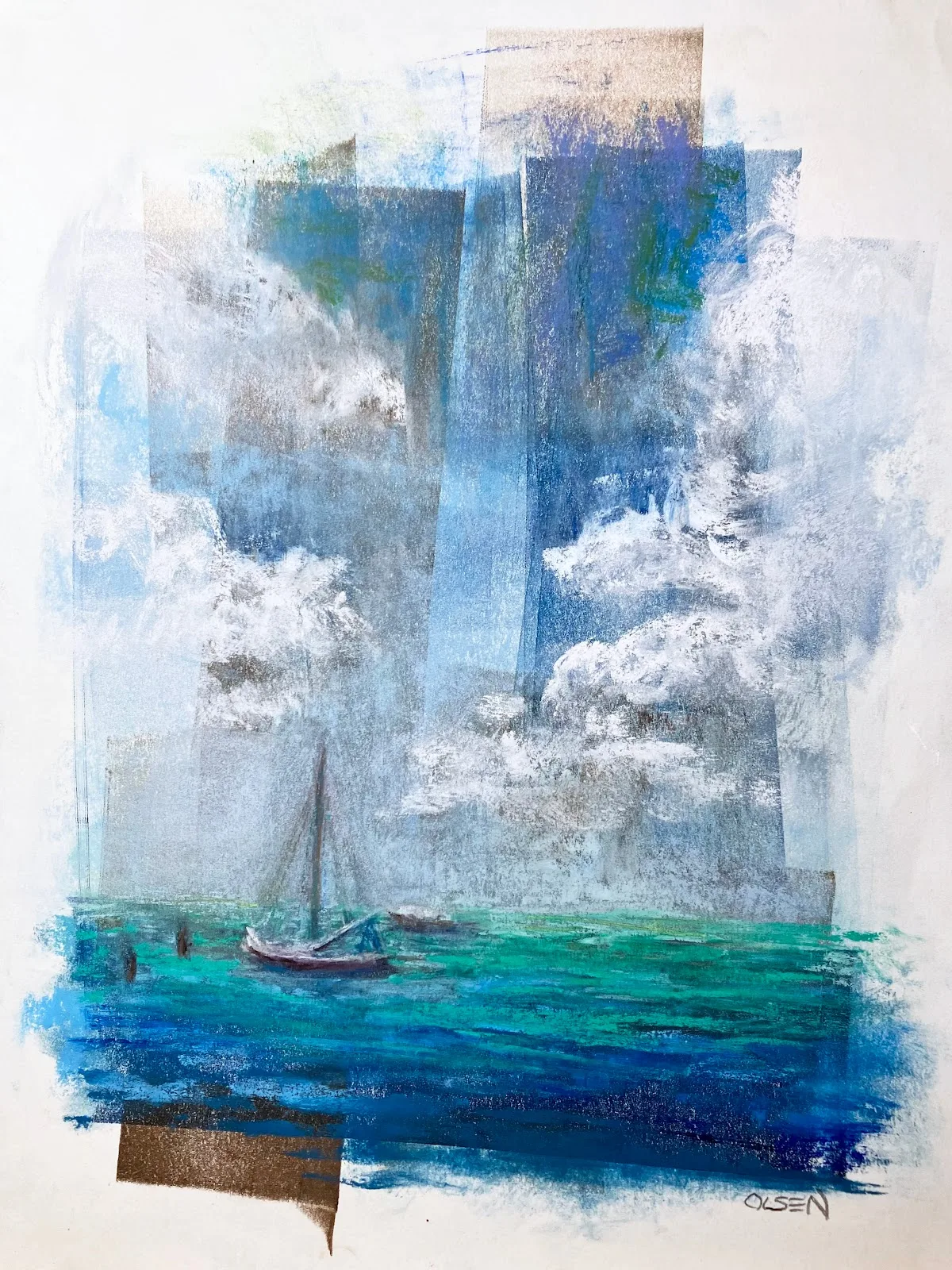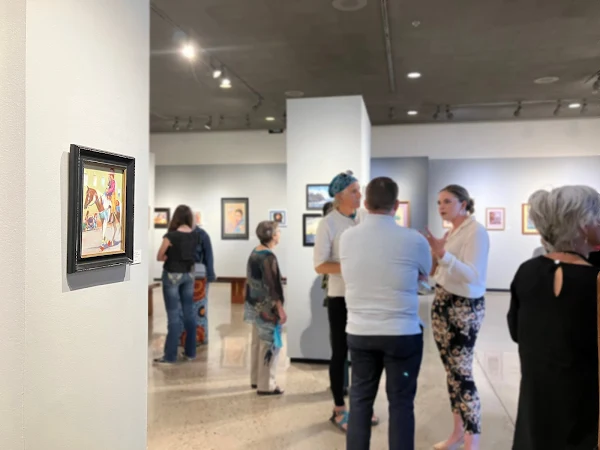Christy Olsen was the guest speaker for the Pastel Society of New Mexico (PSNM) general meeting in September 2014. The PSNM newsletter published a review of the demonstration.

|
| Published Article |
2014 September Program Review
Written by Pat Oliver,
Published by the Pastel Society of New Mexico,
October 2014. p. 3-4.
Our presenter, Christy Olsen, is a third-generation artist who played under her mother's easel growing up and developed an appreciation for art at an early age. Her aunt, mother, and grandmother were all artists. She received her formal education from the University of Tennessee in Knoxville, where she studied the Old Masters and graduated with a degree in Art History and Anthropology.
Christy's work has been shown in exhibitions across the United States, including the "2014 Best and Brightest" exhibition at the Scottsdale Artist's School and the Porter Hall Gallery at the Tucson Botanical Gardens in 2013. She was also a finalist in the "2014 Richeson 75 Still Life and Floral" art competition and the "2014 NOAPS International Juried Open Exhibition." Christy lives in Tucson, Arizona, where she is very active in the local arts community of Southern Arizona and teaches studio art classes. She is a member of the Tucson Pastel Society.
See Christy Olsen's website at ChristyOlsen.com.
Christy Olsen holds several jobs — Drawing Teacher, Teacher of Pastel Classes, and Systems Engineer. Also, early in her career, she did drafting by hand. While these pursuits may seem unconnected, Christy has found that they complement each other in her painting. Drafting taught her how to think in three-dimensional space. Drawing taught her how to take complex ideas and simplify them. Systems engineering disciplines her to combine all the aspects (line, value, shape, size, space, texture, and color) into a system. It is a "highly complex process with many elements to consider." Her purpose this day was to show us how to work through the elements in the context of relationships rather than in isolation (as is sometimes evidenced when a modification to one thing makes everything else seem "out of whack" The systems approach is to take complicated systems and work them into smaller pieces, then see how the pieces work together. The stages of a painting are (1) drawing, (2) painting, i.e., adding color, and (3) refinement.
A Systems Approach to Painting - About the Demonstration
Christy said she likes to paint bigger pictures because she doesn't like to do the framing herself. Bigger paintings can be fragile, so she ships them with Plexiglas. Her favorite paper is the French Sennelier paper (LaCarte), but she has found it is not completely consistent in color. She likes the mid-tones that "help pull out the lights and darks. "She uses the Dakota box for her pastels because the pastels don't break if the box drops. Christy added straps to her box for carrying and also for strapping it to her easel. (She weighs it by hanging her purse from it to hold it steady.)
In the demo, she used a computer image of a vase and flowers displayed on an iPad for reference because it is better than a photo. However, working from life is best. She said, "I like to work from life; otherwise, it is flat."
First, Christy started her drawing using charcoal (Nitram charcoal regular HB - Nitramcharcoal.com) because "it is a very forgiving drawing tool. If I make a mistake, I can just take it off." She starts with design elements and uses a plumb line to measure the subject. She doesn't like to box it in at the beginning, but "just get something going so you can manipulate it," i.e., doing a gesture drawing just to get it in. As she worked, she emphasized that she didn't want to "get it too tight too fast" but was "blocking in gestures, looking at the proportions, and checking that the objects are in the right place."
Once the gesture drawing was on the paper, Christy took a mirror and looked back at the drawing over her shoulder to make sure it didn't tilt to one side and to see what to adjust. Still using charcoal, she looked at the values before getting into color. Then, she begins shading in the darkest darks.
Question: Do you worry about charcoal polluting the colors?
Answer: No, because my pastels are opaque. It will show through them as darker values so long as I don't blend too much. When using charcoal to draw, it's not so intimidating. It feels freer.
In regard to specific colors, Christy said, "I have no idea how it (the color) will end up. As soon as I put it down, it was affected by the color of the paper, which is the effect of simultaneous contrast (everything is affected by everything around it)." Because of this effect, she tested each pastel color on a side strip of paper before using it. As she applied the pastel colors, she emphasized that she was not rubbing them in but keeping them loose and fresh. She usually works only two to three hours at a time to keep the painting fresh. She uses the edge of pastels to get the right hue, chroma, and value for an impressionistic approach (versus rendering).

|
| Pastel Demonstration by Christy Olsen |
Christy likes Unison half-sticks, but her favorites are Henri Roche. They cost more but last a long time because she is not pressing or blending (to blend with Henri Roches, she would use a brush). The closest to Henri Roche she has found are Diane Townsend's pastels. She loves the pumice in these pastels because it gives them a little texture, a breathiness, or airiness.
At this point, Christy was starting on the lights, a warm yellow for the flowers. Also, she was softening hard edges so they would recede. She doesn't completely cover the paper, using the color of the paper as part of the painting. She said, "For a long time, I didn't submit work to shows because I didn't cover the entire surface. Then Richard McKinley told me that's old school." Christy said she likes a lot of paper to show through. In her finished paintings, the paper is part of the painting. She also uses a cloth to "fuzz out" the background.
She was using Great Americans for the softened areas because they are a lot softer. She said, "Sometimes they are too textured, so I take a Holbein to work it in a little, to put texture more in the foreground." As she continued, she said she was "painting in the negative—adding neutral around the flowers, for example, and using cloth to soften the transitions." Because time was limited, Christy showed an earlier study of the same painting she was demonstrating to illustrate how the process proceeded. She concluded that it is important to spend time on the drawing and that "color is the icing on the cake."
About the Host
The Pastel Society of New Mexico (PSNM) is a nonprofit art guild or organization formed in 1989 by a small group of artists seeking to promote the appreciation of the soft pastel medium and contribute to the growing arts community in New Mexico. Although PSNM is based in New Mexico, its membership now includes artists from more than half the states in the nation. For more information, visit www.pastelsnm.org.
Event Date & Time
September 13, 2014 (10:00 a.m. - 12:00 p.m.)
Refreshments served.
Location
Albuquerque Museum (Auditorium)
2000 Mountain Rd NW, Albuquerque, New Mexico 87104
Admission
This event was open to the general public and art guild members. Admission was free.

|
| Photo from the event |





















